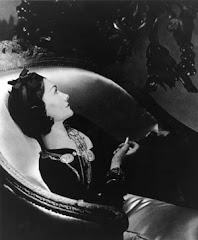My piece in today's Telegraph about Madame Gres
For many years I had heard the name Madame Grès and thought I knew who she was, for it conjured an image of one of the indefatigable Mayfair dressmakers who, from the 1930s to the 1950s, ran up copies of French fashions for well-dressed Englishwomen without the budget for the originals. But Madame Grès was the original, a Paris couturière to rival Lanvin and Chanel, once as famous as both of them. In her time she dressed Marlene Dietrich, the socialite Nan Kempner, Jacqueline Onassis and Barbra Streisand. That she is now forgotten, and her house merely a name in license held by a Swiss company, is a lesson in the difficulties of charting a course into the fashion history books.
Madame Grès photographed by Diane Arbus for 'Harper’s Bazaar' All clothes at some point take on the appearance of fancy dress before they are reincorporated into fashion again, but not hers. Looking at the dresses she made in the 1930s, one is struck not by their modernity but also by their timelessness. Influenced by the ideals of classicism, she made evening gowns that sculpted the human form, using techniques practised only by herself, a specialist skill known as draping, quite distinct from tailoring.
Why is she not better known? As a new book, Madame Grès: Sphinx of Fashion, reveals there were several reasons: because she made some disastrous business choices; because for the first part of her career she designed under another name and had to rebuild her reputation during the difficult circumstances of the German occupation; and because she never courted publicity. Working in complete solitude, she was 'more Garbo than Garbo', according to the fashion journalist Cathryn Horn. Only in the aftermath of her death and the bizarre revelations about her fate - she died penniless, forgotten, the announcement of her death suppressed by her daughter - did she come again to public attention.

